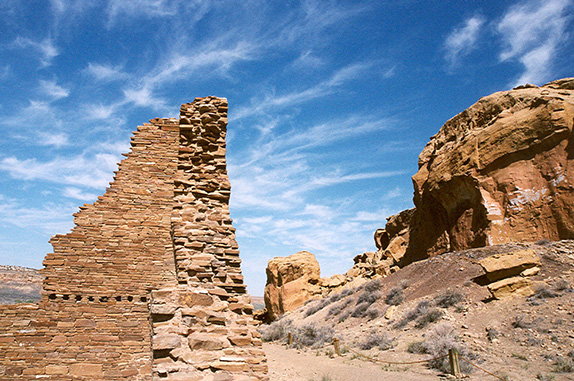 (Photos by Margaret Randall)
(Photos by Margaret Randall)
At Chaco Culture National Historic Park much is apparent but much remains hidden. The place hides as many secrets as it reveals. What one sees is breathtaking. What one cannot see but only feel, also awes the spirit. A vast solitude describes the landscape: once probably greener and more sustaining of life, today dramatically desolate, a mystery only partially unfolding.
The broad but shallow canyon, formed by dusty Chaco Wash in northwestern New Mexico, sits on the Colorado Plateau within the San Juan Basin. The Chuska Mountains lie to the west, the San Juan’s to the north, and the San Pedro’s to the east. Between low canyon walls, the site retains much of what were once a series of Great Houses, multi-storied edifices embracing plazas, kivas, and voices that cannot be silenced.
Seismic movement and time have toppled the uppermost reaches of these houses, such that what we see today is a shadow of what existed 900 years ago. Different interests have promoted different sorts of excavation. Some of the houses have been cleaned and stabilized, others were explored for objects or data and then backhoed to invisibility.

What we visit comprises a dozen or so partially restored freestanding ceremonial centers situated around a one-way 9-mile loop drive. The largest of these, Pueblo Bonito, has some 650 rooms, two great kivas and many smaller ones (at the Great Houses, there was a ceremonial kiva for every 30 or so rooms; the larger kivas could hold as many as 400 people). Other much smaller ruins barely receive visitors. The most prominent houses are Pueblo Alto, Hungo Pavi, Kin Kletso, Chetro Ketl, Una Vida, Peñasco Blanco, Pueblo del Arroyo, Casa Rinconada, and the aforementioned Pueblo Bonito—names from the Indian and Spanish, given them by adventurers, explorers, and social scientists.
If one follows the path from Pueblo Bonito to Chetro Ketl, a few petroglyphs can be seen along the backdrop cliff. Some of these are riddled with bullet holes, evidence of sad abuse wrought by those whose surplus testosterone or misplaced anger outweighs respect. A variety of other petroglyphs exist throughout the canyon.

The Chacoan builders used core-and-veneer architecture and multi-story construction requiring massive masonry walls up to three feet thick. The long outer walls at Pueblo Bonito and Chetro Ketl are particularly impressive. Chaco’s stone technique differs from other examples of Colorado Plateau construction of the period: thin layers of carved blocks sometimes interspersed with rows of smaller stones, exquisitely cut windows and keyhole doors, beautifully joined walls. Even over several decades, as new architectural forms replaced old, the Great Houses kept their signature characteristics. Most obvious of these was their scale. The complexes average more than 200 rooms each, a few many more.
The rooms within the Great Houses were also large, their ceilings higher than earlier Ancestral Puebloan constructions. And the rooms weren’t tacked on as needed. Instead major sections or wings were erected at a time. The houses generally faced south and often stood four or five stories high. Forms descended and opened up to the south or southeast, thus affording shelter from northwesterly winds, shade from the hot afternoon summer sun, and warmth in the winter.
Stephen D. Dent and Barbara Coleman write: “[R]esearch reveals a widespread net of solar, lunar, and cardinal markings and relationships both within the individual structures and connecting the major buildings in the canyon.” They add that they would be surprised if “the Chacoans did not comprehend and mark solar geometry and its relation to natural cycles. Anyone who has slept beneath those clear skies or walked in the valley can attest to the impact and power of the sun, moon, and stars in one’s perception of place.” (Anasazi Architecture and American Design, Edited by Baker H. Morrow and V.B. Price, University of New Mexico Press, 1997, p. 56). To the lay person’s eyes, the most obvious difference between the edifices at Chaco and most other sites of the period, was the fact that the latter were built in rock alcoves while the former were freestanding.
As Santa Clara architectural and art historian Rina Swentzell has pointed out, however, looking at Ancestral Puebloan architecture from a purely Western perspective is a mistake. “In the Western world,” she writes, “architecture is altogether contained within the human landscape: it […] is about human genius and ego. […] Pueblo people over the last fifteen hundred years [do not consider construction] out of their relationship to the hills, valleys, and mountains. Buildings and structures, and their walls, are not the primary focus. They are extensions of the natural world and therefore do not call attention to themselves or their makers. They are meaningful only as containers—for the function served by the described spaces and for the cosmic relationships that they reiterate.” (Anasazi Architecture, p. 155-6).
In this sense, the Great Houses within the overall landscape provided their inhabitants with a deep sense of place, such that the people at Chaco knew where they were at all times. They possessed spatiality. They felt at home.
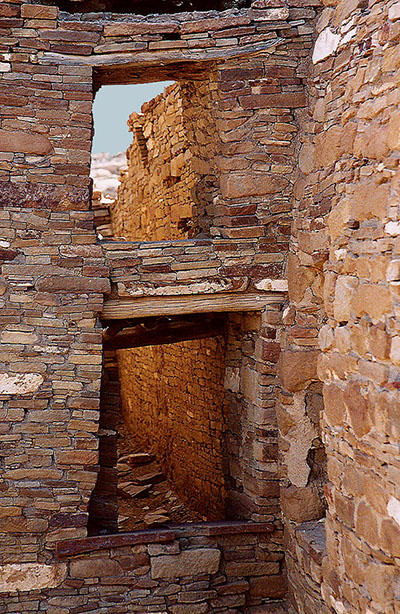
One of the great “unseen” features of Chaco is the map of perfectly straight ancient roads leading north, west, and south. These avenues, sometimes doubled and even quadrupled, are much too wide to have been constructed only for the movement of humans. They lead directly to places where natural landmarks and outlier communities existed. They have been called sacred ceremonial corridors. In Puebloan cosmology they also led from and to the underworld. Today they can be devised via aerial photography and other remote technologies. Chaco clearly functioned as a great ceremonial center, and connections with sites 150 miles distant have been established.
Seen and unseen, Chaco is spectacular. Two hours north of Albuquerque on State Highway 550 and just past Cuba, New Mexico, travelers turn west and then north again onto 5 miles of pavement and another 16 of graded earth. When I was a child, one had to approach from the south, turning north off I-40 at Thoreau; the road was so bad that it wasn’t uncommon for cars to get stuck and their drivers give up before reaching the site. Very few visitors made it to the ruins.
Today it’s an easier journey. The last few miles of unpaved road present problems only after unusual amounts of rain—sadly less and less of a danger. Passing through Navajo grazing country dotted by the occasional Hogan and water tank, landmark Fajada Butte soon makes its appearance on the horizon. A small campground (reservations required) and visitor center come next. Leaving the latter, no one for whom it is a first visit is prepared for what follows.

The Great Houses appear one after another. The first couple of these demand close attention; their crumbling shapes seem to dissolve into the canyon walls. Then the larger houses come into view, their silhouettes more clearly defined. Most visitors stop first—or only—at Pueblo Bonito. There is enough at that site for a day’s exploration, including a climb through a narrow crack in the mesa wall so one can walk on the cliff above the ruin, looking down as if on a scale-model magnified a thousand-fold.
In truth one can spend weeks or months at Chaco and not decipher her secrets; sadly, the average recorded visit is only a couple of hours. Early spring and fall are the best times to go; anyone but the hardiest desert hiker would do well to avoid the harsh summer heat in such an unprotected place. At this point on our environmental calendar, there isn’t a tree in sight. The ruins may receive three or four snows during a typical winter, and monsoon season can bring dramatic thunderstorms.
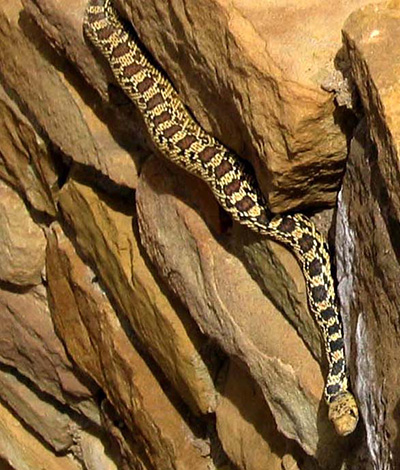
In 1941, despite efforts to prop it up, a 30,000-ton wedge of sandstone early anthropologists called “Threatening Rock” finally crashed against the north side of Pueblo Bonito. It destroyed some of the north wall and all or parts of 65 rooms. Extensive stabilization of all the ruins at Chaco began in 1933, and has been fairly successful in preserving the great houses and other buildings—although some of the methods used have since been deemed inhibiting to ongoing research.
Chaco was built and used as a ceremonial center between 850 and 1200 AD. What were the ceremonies like? Who really knows? I have sensed fear and violence as well as fecundity, creativity, and the spark that renews life one generation to the next. There is sparse evidence of large numbers of people having lived in the Great Houses. Smaller living sites have been discovered elsewhere throughout the area. The Chacoan architects quarried sandstone blocks and timbers, and hauled them from great distances. The beauty and complexity of their stonework makes it unique among Ancestral Puebloan ruins. Until the 19th century, the 15 main houses were the largest buildings standing anywhere in the United States.
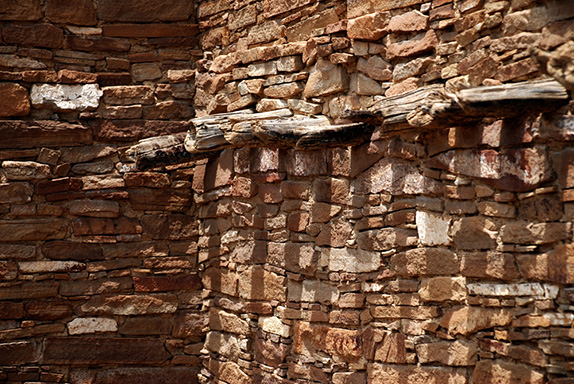
New Mexican governor José Antonio Vizcarra was the first to document Chaco. He led an expedition through the wash in 1832 and noticed several of the structures. It would take the anthropological community half a century to catch up. The American Museum of Natural History finally sponsored the Hyde Exploring Expedition, which began excavating Pueblo Bonito in 1896.
Self-taught explorer Richard Wetherill, who had worked for the Hyde Expedition, was fascinated by Chaco. He wanted to continue digging at the place, and claimed a homestead of 161 acres that included Pueblo Bonito, Pueblo del Arroyo, and Chetro Ketl. Investigating Wetherill’s claim, federal land agent Samuel J. Holsinger began making a study of the canyon and its sites. He urged the creation of a National Park to safeguard the ruins.
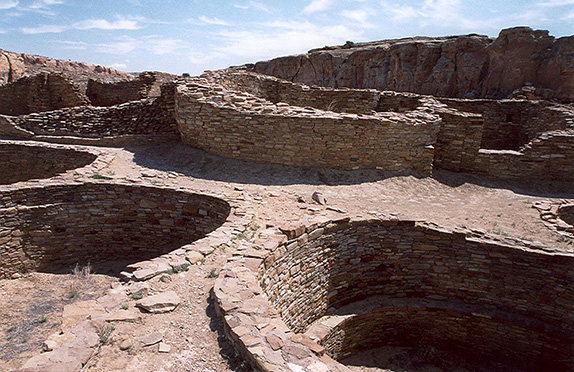
In the early years of the 20th century a first wave of US anthropologists gained prominence. This was a time when the burgeoning discipline was staking its claim: new interest and ideas, improved research methods, political fiefdoms, defense of turfs and professional jealousies invaded the US American Southwest. More positively, meetings began taking place at which experts from a variety of related fields began sharing information and analyses. Much of what happened in the first decades of the 20th century determined what today’s visitors to Chaco see, and also what they don’t.
Edgar Lee Hewett, president of New Mexico Normal University (later Highlands University, in Las Vegas), helped enact the Federal Antiquities Act of 1906. This was the first US law to protect archaeological sites and their relics. When President Theodore Roosevelt proclaimed Chaco Canyon National Monument in 1907, Wetherill was forced to relinquish his homestead claim.

The National Geographic Society began work at Chaco in 1920. The University of New Mexico entered the picture mid-century. Wetherill, whose heart remained at Chaco, was prohibited from excavating there; the experts claimed he was an amateur and, as such, a danger to the site’s integrity. But Wetherill continued to live and work nearby until 1910, when he was shot and killed by a Navajo man in an incident that has only been partially clarified. He is buried a short walk from Pueblo Bonito, in a barren little cemetery where his is the only grave. Wetherill is surely one of the unseen spirits roaming the place. And today his overall legacy has mostly been redeemed.
After five summers at Chaco, the Hyde expedition sent more than 60,000 artifacts back to New York—pottery, stone implements, bone and wooden objects, some fabric, a few copper bells traded from farther south, and thousands of turquoise beads, pendants and mosaic ornaments. Starting in 1981, a new approach informed by traditional Hopi and Pueblo beliefs, stopped the dismantling of walls and extraction of treasure. Remote sensing, Indian oral tradition, and dendrochronology gained in favor. The Chaco American Indian Consultation Committee was established in 1991, in order to give Navajo, Hopi, Pueblo, and other Indian representatives a voice in the park’s management.
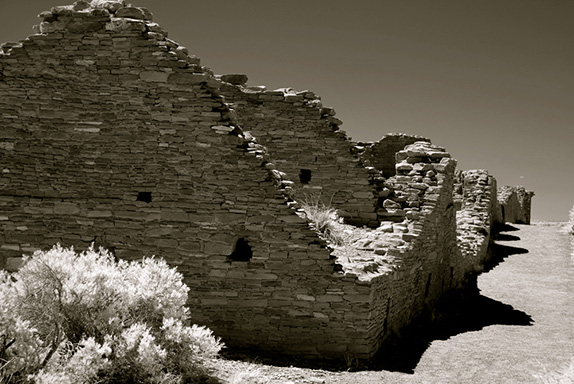
Still contested in some circles, not yet completely understood, and only partially seen by the visitor, is what archeologists now agree is the perfect alignment of buildings and natural land features many miles distant from one another. Some of these were line-of-sight signaling stations. Others provide evidence of advanced astronomical knowledge. The summer solstice always brings hundreds of people—from passionate New Agers to those with a serious interest in the Ancients’ cosmology—to gather at Casa Rinconada and watch for the moment when a beam of sunlight shines through a window in the south side of the structure and reflects itself straight into a niche on the opposite wall.
Dr. Anna Sofaer has had an important astronomical study going at Chaco since 1978. That season, her Solstice Project's research team documented light markings such as the “Sun Dagger” atop Fajada Butte. At equinox a needle of light pierces a smaller spiral, and at winter solstice two parallel light daggers bracket a larger one. In 1979, Solstice Project's research revealed that the moon’s shadow patterns on the larger spiral also marked the 18.6-year lunar standstill.

The lunar standstill is one of those phenomena we both see and don’t. As the earth spins on its axis, the stars above us appear to move in circles. We “see” the stars as fixed in a great sphere surrounding us. Just as we measure positions on the earth using latitude and longitude, we measure the positions of stars in right ascension equivalent to longitude, and declination equivalent to latitude. The lunar standstill is a position in relation to the motion of the lunar orbit turning in fixed space. At a major lunar standstill, which takes place every 18.6 years, the range of the declination of the moon reaches its maximum expression. Sofaer has called the lunar standstill “the middle of time.”
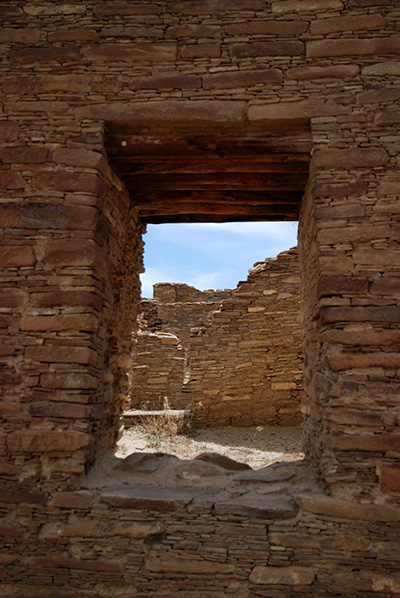
As with all ancient sites, especially those where the people who built and inhabited them left no written record, there are many less esoteric questions to be answered about Chaco. What kind of ritual took place at the Great Houses; did people live in them, were they exclusively ceremonial in nature, or both? And the question that has been asked over and over since the abandoned sites were discovered by non-native explorers: what caused the abandonment and where did the people go?
Climate change clearly had something to do with why these sites emptied out. During their period of greatest use, irrigation and communal gardens would have served Chaco’s inhabitants. A severe 50-year drought, documented from the mid to late 10th century, made it impossible for the site to support its large population. It is now generally agreed that people moved further south, into the Rio Grande Valley where better farm and grazing lands were available.

To date, in my opinion, among the best resources on Chaco’s development and demise are Anasazi Architecture and American Design, already cited, and David E. Stuart’s Anasazi America. The former brings together texts by a number of thinkers in many different disciplines, and also situates Chaco within the context of Ancestral Puebloans generally. The latter is not only meticulous in its organization of information and courageous in its analysis, but draws lessons for contemporary US Americans in terms of what will happen to us if we continue to deplete land, water, and the quality of our air. The people at Chaco can’t be blamed for overusing their resources. They did amazingly well with the information they were able to gather. We know so much more, yet show no signs of changing course in any meaningful way.
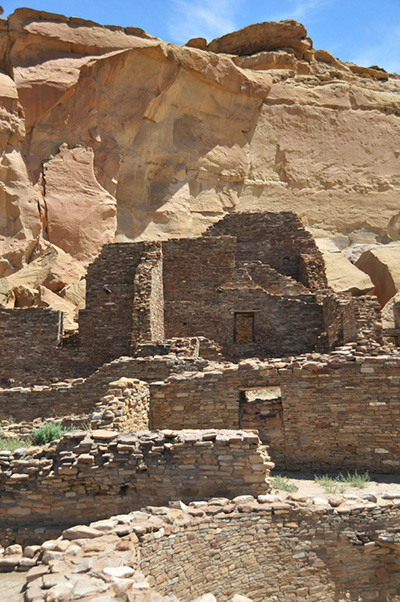
As I say, what we do not see at Chaco moves us as much as what we do. The site calls out to poets and other artists, and many have taken the place as a point of departure for major works. No suite of poems, in my reading, is more powerful than V.B. Price’s Chaco Body. Artspace New Mexico produced a beautiful edition, with exquisite black and white photographs by Kirk Gittings and an informative foreword by Michael P. Marshall.
Marshall writes of a “sacred geography, a kind of Holy Land.” And in Chaco Body II, Price writes: “Never freed from now, / I cannot hear them, / I can have / no memory of their lives. / Their voices are behind me // even though I am / what they have left behind. / As if time / were whole / and still behind the lives of those / who cannot hear me now, / I am the heir of their imagining . . .” Unfortunately, this edition sold out quickly. I keep hoping for a reprint. Until then, a selection of the poems can be found in Price’s Broken and Reset: Selected Poems 1966-2006.
Beneath the earth at Chaco, and pushed to the surface by wind and infrequent rain, there is a discourse of broken pottery shards and other evidence of human activity only partially understood. Conventional wisdom (and National Park Service regulation) stipulate one not remove anything, not even the smallest piece of pottery or unusual rock. Generally I adhere to this dictum.
Once, though, walking across Chaco’s century-swept landscape, my partner’s eye caught a single tiny turquoise bead. She picked it up and placed it in my palm. It couldn’t have been more than a couple of millimeters round. Nestled between my fingers, it seemed to change the temperature of my skin. No sign of the string or thread that once linked it to other beads. I confess I could not return it to the earth. It speaks to me of questions I do not know how to ask, and answers that float beyond my reach: Chaco’s seen and unseen truths.
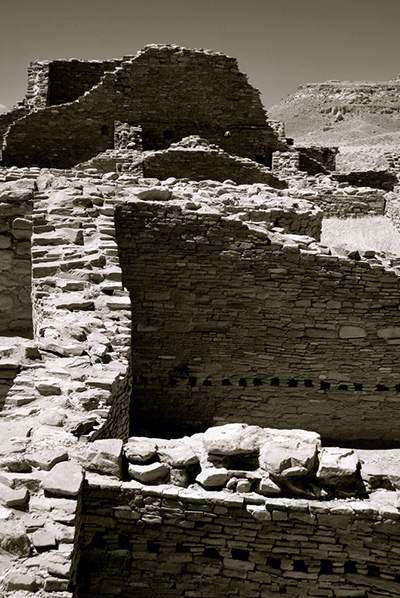




Responses to “Chaco: Seen and Unseen”